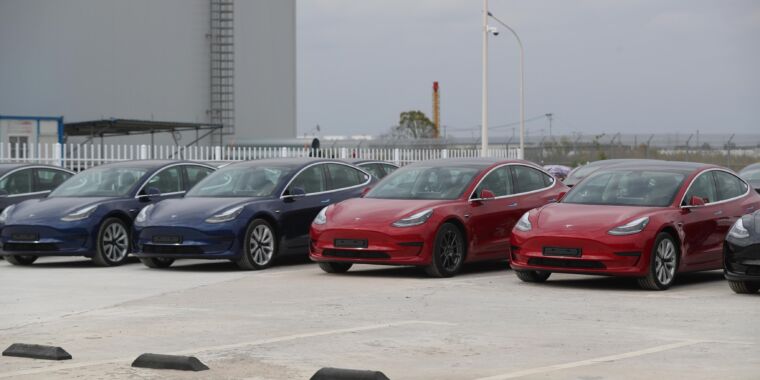Zhang Hengwei/China News Service via Getty Images
All versions of the Tesla Model 3 sedan now qualify for the full IRS clean vehicle tax credit. Tesla CEO Elon Musk used Twitter to share the news last week, but it has now been confirmed by the federal government on its consumer-facing fueleconomy.gov site. However, given Tesla’s lack of a communications department, it’s unclear exactly what has changed that allows this electric vehicle to qualify once again.
Until the end of 2022, the IRS offered a tax credit of up to $7,500 for qualifying plug-in vehicles. The size of the credit was based on battery capacity, and there was a provision to sunset the tax credit for a given manufacturer once it sold more than 200,000 plug-in vehicles. As Tesla only sells plug-in vehicles, it was the first to hit this cap, reaching that milestone in the second quarter of 2018. (General Motors was the only other OEM to also pass this milestone; it did so at the end of 2018.)
All that changed at the start of this year, thanks to the Inflation Reduction Act. Now the tax credit applies to clean vehicles rather than plug-in vehicles, allowing a credit for hydrogen fuel cell EVs as well as plug-in hybrid and battery EVs. And there’s no more sunset, and Tesla and GM vehicles are not disqualified due to sales success. As before, it’s a tax credit, so the filer needs to have at least as large a tax liability as the credit.
But there are many more conditions than before. To qualify, a clean vehicle has to be assembled here in North America, which rules out quite a lot of EVs immediately (although this does not apply if you lease). There are income caps and price caps—no sedan qualifies if it costs more than $55,000, and other body styles must cost less than $80,000. The battery capacity must be at least 7 kWh, and the vehicle’s gross weight rating must be below 14,000 lbs.
At first, the IRS declined to enforce the full clean vehicle tax credit guidelines, specifically the ones tied to the battery’s origin, although this changed in April. The credit is actually split in half based on two different factors. $3,750 is contingent upon the critical minerals in the battery pack having been extracted or processed in the US, or a country with which we have a free-trade agreement. For 2023, at least 40 percent of those minerals must satisfy that clause in order to qualify, but it increases each year until 2027, when 80 percent of the critical minerals must be domestically sourced.
The other $3,750 is tied to the value of the battery components. At least 50 percent of the value of the pack must be assembled or manufactured in North America, and this also increases year by year until 2029, when the entire pack’s value must be North American in origin.
The way the IRS chose to classify whether a vehicle was a sedan or not initially left out some rather obvious non-sedans like the Cadillac Lyriq, Tesla Model Y, and Volkswagen ID.4, and Tesla has adjusted its prices, allowing more and more Model 3 and Model Y variants to qualify.
-
The Model 3 Long Range was not available for the last nine months. Now it’s back, but with about 10 percent less range than before. This probably indicates a change of battery supplier.
Tesla -
Fueleconomy.gov lists the Model 3 Long Range at 358 miles.
EPA
When the full rules went into effect in April, the Model 3 Performance qualified for the full $7,500, and the Model 3 Standard Range qualified for a $3,750 credit due to the sourcing of its battery cells from China’s CATL rather than Panasonic. And when Tesla reintroduced the Model 3 Long Range at the beginning of May, it, too, qualified for half the tax credit.
According to the IRS and the EPA, all versions of the electric sedan now qualify for the full $7,500. The big question is how, and without a comms department, the automaker is not saying. One possibility is that importing Chinese-made Teslas to countries like Canada has freed up US-produced cars for US consumption. One clue to different cells in the cars is a downgrading of the Model 3 Long Range’s range, which has dropped from 358 miles to 333 miles.


